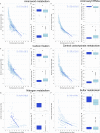Linking prokaryotic genome size variation to metabolic potential and environment
- PMID: 36973336
- PMCID: PMC10042847
- DOI: 10.1038/s43705-023-00231-x
Linking prokaryotic genome size variation to metabolic potential and environment
Abstract
While theories and models have appeared to explain genome size as a result of evolutionary processes, little work has shown that genome sizes carry ecological signatures. Our work delves into the ecological implications of microbial genome size variation in benthic and pelagic habitats across environmental gradients of the brackish Baltic Sea. While depth is significantly associated with genome size in benthic and pelagic brackish metagenomes, salinity is only correlated to genome size in benthic metagenomes. Overall, we confirm that prokaryotic genome sizes in Baltic sediments (3.47 Mbp) are significantly bigger than in the water column (2.96 Mbp). While benthic genomes have a higher number of functions than pelagic genomes, the smallest genomes coded for a higher number of module steps per Mbp for most of the functions irrespective of their environment. Some examples of this functions are amino acid metabolism and central carbohydrate metabolism. However, we observed that nitrogen metabolism was almost absent in pelagic genomes and was mostly present in benthic genomes. Finally, we also show that Bacteria inhabiting Baltic sediments and water column not only differ in taxonomy, but also in their metabolic potential, such as the Wood-Ljungdahl pathway or the presence of different hydrogenases. Our work shows how microbial genome size is linked to abiotic factors in the environment, metabolic potential and taxonomic identity of Bacteria and Archaea within aquatic ecosystems.
© 2023. The Author(s).
Conflict of interest statement
The authors declare no competing interests.
Figures






Similar articles
-
Microbial functional genes are driven by gradients in sediment stoichiometry, oxygen, and salinity across the Baltic benthic ecosystem.Microbiome. 2022 Aug 15;10(1):126. doi: 10.1186/s40168-022-01321-z. Microbiome. 2022. PMID: 35965333 Free PMC article.
-
Microbial river-to-sea continuum: gradients in benthic and planktonic diversity, osmoregulation and nutrient cycling.Microbiome. 2021 Sep 20;9(1):190. doi: 10.1186/s40168-021-01145-3. Microbiome. 2021. PMID: 34544488 Free PMC article.
-
A Genomic Perspective Across Earth's Microbiomes Reveals That Genome Size in Archaea and Bacteria Is Linked to Ecosystem Type and Trophic Strategy.Front Microbiol. 2022 Jan 5;12:761869. doi: 10.3389/fmicb.2021.761869. eCollection 2021. Front Microbiol. 2022. PMID: 35069467 Free PMC article. Review.
-
Patterns in Benthic Microbial Community Structure Across Environmental Gradients in the Beaufort Sea Shelf and Slope.Front Microbiol. 2021 Jan 28;12:581124. doi: 10.3389/fmicb.2021.581124. eCollection 2021. Front Microbiol. 2021. PMID: 33584606 Free PMC article.
-
The importance of benthic-pelagic coupling for marine ecosystem functioning in a changing world.Glob Chang Biol. 2017 Jun;23(6):2179-2196. doi: 10.1111/gcb.13642. Epub 2017 Mar 22. Glob Chang Biol. 2017. PMID: 28132408 Review.
Cited by
-
High wax ester and triacylglycerol biosynthesis potential in coastal sediments of Antarctic and Subantarctic environments.PLoS One. 2023 Jul 17;18(7):e0288509. doi: 10.1371/journal.pone.0288509. eCollection 2023. PLoS One. 2023. PMID: 37459319 Free PMC article.
-
Microbial cross-feeding stabilized by segregation of a dependent mutant from its independent ancestor.ISME J. 2025 Jan 2;19(1):wraf131. doi: 10.1093/ismejo/wraf131. ISME J. 2025. PMID: 40568968 Free PMC article.
-
Genome-streamlined SAR202 bacteria are widely present and active in the euphotic ocean.ISME J. 2025 Jan 2;19(1):wraf049. doi: 10.1093/ismejo/wraf049. ISME J. 2025. PMID: 40197742 Free PMC article.
-
New perspectives on picocyanobacteria and understudied cyanobacterial diversity in the Albemarle Pamlico sound system, North Carolina, USA.Front Microbiol. 2025 May 9;16:1539050. doi: 10.3389/fmicb.2025.1539050. eCollection 2025. Front Microbiol. 2025. PMID: 40415923 Free PMC article.
-
DNA Damage, Genome Stability, and Adaptation: A Question of Chance or Necessity?Genes (Basel). 2024 Apr 21;15(4):520. doi: 10.3390/genes15040520. Genes (Basel). 2024. PMID: 38674454 Free PMC article. Review.
References
-
- Rodríguez-Gijón A, Nuy JK, Mehrshad M, Buck M, Schulz F, Woyke T, et al. A genomic perspective across Earth’s microbiomes reveals that genome size in Archaea and Bacteria is linked to ecosystem type and trophic strategy. Front Microbiol. 2022;12:761869. doi: 10.3389/fmicb.2021.761869. - DOI - PMC - PubMed
-
- Lynch M. Streamlining and simplification of microbial genome architecture. Annu Rev Microbiol. 2006;60:327–49. - PubMed
LinkOut - more resources
Full Text Sources
Miscellaneous

